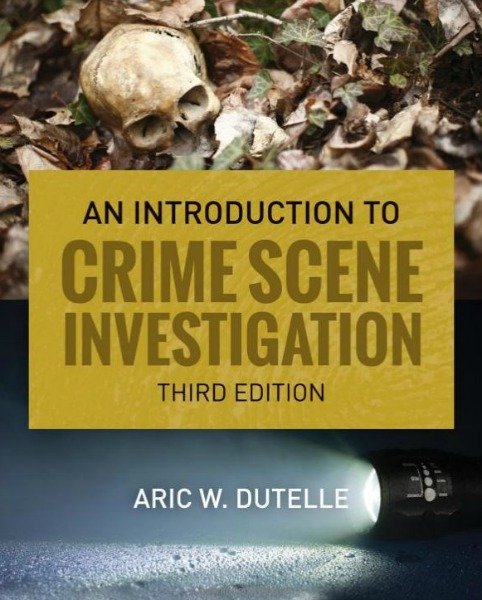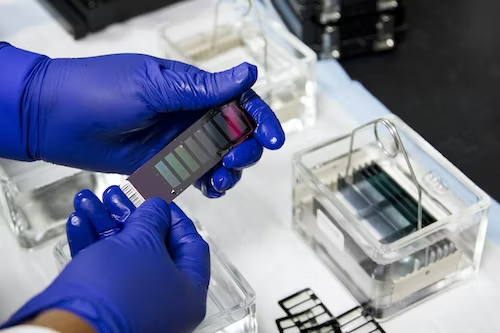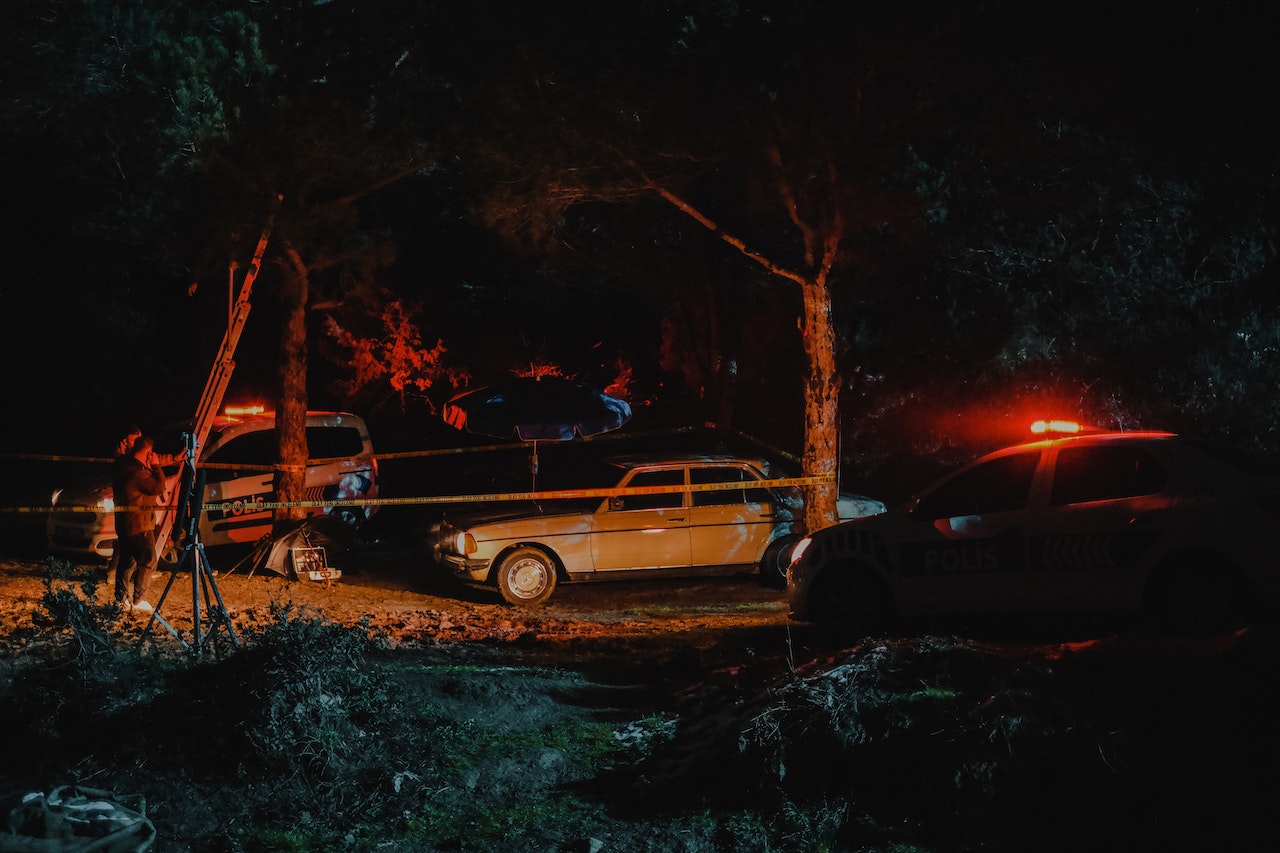Crime Scene Collection Techniques
The importance of avoiding cross contamination cannot be overemphasized. The crime scene investigator performing the collection must ensure tools are clean or sterilized and that gloves are changed between handling each sample.
Crime scene collection techniques differ depending on the type of evidence and the substrate upon which it is found. It is preferable to collect evidence in its original state. If the evidence is fragile or can easily be lost, the entire object should be collected and packaged, if size and circumstances permit.
Some laboratories recommend the submission of substrate controls. Substrate controls are clean samples of the collection materials or unstained portions of the material the biological evidence is deposited on. The laboratories can use these to troubleshoot contamination, Polymerase Chain Reaction (PCR) inhibition, or interference with fluorescence.
The investigator should consult the local forensic laboratory and refer to the department standard operating procedures regarding crime scene collection techniques and preservation of biological evidence.
Crime Scene Collection Techniques For Blood & Other Body Fluids
Cuttings:
Removal of a section of the item containing the stain using a sterile or clean cutting device.
Wet Absorption:
|
A sterile swab, gauze pad, or threads are slightly moistened with sterile distilled water. An effort should be made to concentrate the stain in a localized portion of the swab or pad. For example, when using a swab, the stain should be concentrated on the tip. The collection medium is concentrated into the stain and allowed to air dry. Some laboratories recommend following the first moistened swabbing with a second dry swabbing to ensure thorough sample collection. Both swabs are retained and submitted for analysis. |
|
Scraping Method:
Using a clean razor blade or scalpel, the sample is scraped into a clean piece of paper that can be folded and packaged in a paper envelope or other appropriate packaging.
Lifting with Tape:
For dried blood stains on a non-absorbent surface, fingerprint lifting tape may be placed over the stain and lifted off. The stain is transferred to the adhesive side of the tape, which may then be secured on a clear piece of acetate for submission to the laboratory.
Crime Scene Collection Techniques For Hair & Fibers
Visual Collection:
On some surfaces, hairs and fibers can be seen with the naked eye. Using clean forceps and trace paper, the sample can be removed from the surface and placed into a clean piece of paper that can be folded and packaged in a paper envelope or other appropriate packaging.
Tape Lifting:
Water or methanol soluble tapes are available for the collection of trace hair and fiber evidence. The tape is applied to the location of the suspected sample, removed, and packaged.
Vacuuming Method:
The area where the suspected samples are located are vacuumed up and caught in a filtered trap attached to the vacuum. These samples are packaged in clean trace paper for submission to the laboratory. Vacuuming is the least desirable collection method because there is a risk of cross contamination if the equipment is not properly cleaned between each use.
Reference Sample Crime Scene Collection Techniques
Reference samples should be collected from individuals who might be linked to the crime scene where DNA evidence is found. Reference samples can be used for elimination or comparative analysis. For example, buccal swab samples taken from the suspect and/or victim, a known source, should be compared to biological evidence found at the crime scene to eliminate or place them at the scene.
Buccal Swab:
Sterile swabs or other buccal collection devices are rubbed against the inside cheek of the individual's mouth to collect epithelial cells for analysis.
Liquid Blood Samples:
Generally collected in purple topped vacuum tubes that contain the preservative ethylenediamine tetraacetic acid (EDTA).
Packaging & Storage:
Biological evidence should be dried before packaging to minimize sample degradation. Packaging in paper is preferred; however, some laboratories allow packaging in plastic if the sample is thoroughly dried.
Liquid samples, such as water from a toilet bowl or pipes, should be properly documented and packaged in sterile glass or plastic containers and refrigerated as soon as possible.
(Information provided by the Department of Justice)
Essential Reading
In a world heavily influenced by popular forensic television dramas, the real-life duties and complexities involved in crime-scene investigation are often misrepresented and misunderstood. An Introduction to Crime-Scene Investigation, Third Edition is a comprehensive and accurate overview of the practical application of forensic science in crime scene investigation. Focusing on the day-to-day aspects, this full-color text describes the methodologies and technologies employed by crime scene personnel, and pushes the reader to identify the interrelated components of the investigative process.
Recognizing the importance of those who have contributed to and advanced the field of forensic science, the reader is introduced to CSI through a historical perspective. The updated Third Edition covers components not typically found in many crime scene texts, including ethical considerations and public misconceptions of the investigative process—the so-called “CSI Effect.” Extensive discussion of physical evidence examination and analysis is provided, including the forensic potential of physical evidence, crime scene procedures, and what evidence should be documented, collected, and preserved. Real-life examples and over 250 detailed, full-color photos and figures enhance comprehension and demonstrate specific strategies for technique application
While the vast majority of the text is written with an American audience in mind, the author has chosen to call upon his significant international experience and include cases, information, and photographs/figures which are external to the United States.
An Introduction to Crime-Scene Investigation, Third Edition is an invaluable reference and essential educational resource.
See following link for full details.
Introduction to Crime Scene Investigation
Recent Articles
-
The Role of Forensic Evidence in Car Accident Investigations
Jan 30, 24 07:22 AM
Insightful article on the role of forensic evidence in car accident investigations. -
The Role of Forensic Science in Personal Injury Cases
Oct 20, 23 03:56 AM
Insightful article on the role of forensic science in personal injury cases. -
All About Forensic Science
Aug 16, 23 09:53 AM
A forensic science website designed to help anybody looking for detailed information and resources.
Go To The Main Crime Scene Investigation Page
Go From Crime Scene Collection Techniques Back To The Home Page



New! Comments
Have your say about what you just read! Leave me a comment in the box below.